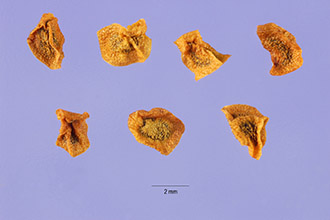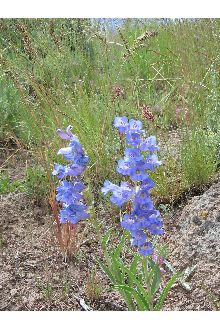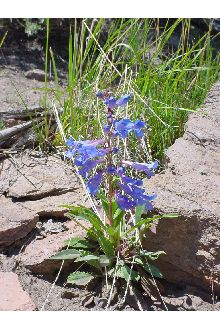Royal Penstemon
Scientific Name: Penstemon speciosus Douglas ex Lindl.

| General Information | |
|---|---|
| Usda Symbol | PESP |
| Group | Dicot |
| Life Cycle | Perennial |
| Growth Habits | Forb/herb |
| Native Locations | PESP |
Plant Guide
Alternate Names
Sagebrush penstemon, showy penstemon, royal beardtongue
Uses
Royal penstemon is chiefly used as a forb component for wildlife habitat enhancement projects and restoration efforts. Its showy flowers attract numerous pollinators and other insects which provide a food source for birds and other vertebrates. This species is also commonly used in xeriscaping and other low-water-use landscaping. It is also suited for roadsides and other beautification projects.
Status
Consult the PLANTS Web site and your State Department of Natural Resources for this plant’s current status (e.g. state noxious status).
Description
General: Figwort Family (Scrophulariaceae). Royal penstemon is a perennial herb/forb reaching 3 to 6 dm (1 to 2 ft) tall. Several ascending to erect stems arise from a branched caudex. Flowers are sky blue reaching 4 cm (1.5 in) long and about 1 cm (0.4 in) wide at the mouth. Leaves are entire and narrow, to 15 cm (6 in) long and 1 to 12 mm (0.04 to 0.5 in) wide, rounded to acute at the tip. The leaves are mostly sessile with some of the upper leaves clasping the stem. Anthers are blue-margined, glabrous, with sacs about 2mm (0.08 in) long, partially dehiscent; the suture line not reaching the connective (Welsh 2003). Flowering season is from May to July. There are approximately 400,000 seeds/lb (USDA-NRCS 2008). Close-up of flowers. Derek Tilley, USDA NRCS Idaho PMC Distribution: Royal penstemon is found in scattered populations throughout the Great Basin Floristic Province. The species is common in western Utah, southern Idaho, and most of Nevada and into east Cascade and Sierra portions of Washington, Oregon and California. Habitat: Royal penstemon inhabits dry flats, slopes and draws in the sagebrush-grass, mountain shrub and juniper forestland communities. Plants typically occur at low to middle elevations in lowlands and foothills from 0 to over 10,000 feet (Hitchcock et al 1959).
Adaptation
This species is adapted to loam to fine sandy loam soils with a pH range of 6.0 to 8.0 (Las Pilitas 2008). For xeriscaping and low water gardening the species is recommended for use in USDA hardiness zones 3a through 7b (Dave’s Garden 2008) in areas receiving greater than 10 inches annual precipitation.
Management
When planted in a native reclamation mix, royal penstemon will be a minor component of the establishing plant community; therefore management should be based on other key species in the mixture. Grazing on seeded lands should be deferred for at least two growing seasons to allow for establishment.
Pests and Potential Problems
Impact from insect pests on penstemon seed production can be significant. Penstemon borer larva can infect the crown and upper root area of all Penstemon species resulting in the loss of individual plants to entire fields. Presently, penstemon borers are known only from extreme southwestern Colorado. Penstemon clearwing (Penstemonia spp.) attacks multiple Penstemon species. The larvae feed within the stems of the crown and lower above ground portion of the plant. A pheromone is available for monitoring of adults. Other potentially significant pests include Lygus bugs and raceme-boring moths (Western Colorado Extension 2008).
Seed and Plant Production
Plant Production , Use soil moisture sensors to measure the soil moisture of Royal Penstemon.
Plant Production
Fields for seed production can be established by transplanting greenhouse grown containerized stock or from direct seeding. Direct seeding should take place in the fall to allow for natural stratification of the seed. Greenhouse materials can be established by seeding into cones or flats in winter for natural stratification or by stratifying the seed for 8 to 12 weeks in cold/moist conditions. Pre-chilling requirements are reduced with a liquid smoke treatment (Shaw et al. 2003). Germination can also be enhanced by watering with a weak solution of gibrillic acid (250 ppm) though treated seedlings appear to be less vigorous than non-treated. Royal penstemon plants have also been successfully propagated from herbaceous stem cuttings (Dave’s Garden 2008). Seed should be sown to a depth of 0 to 6 mm (0 to 0.25 in). In herbicide tolerance screening trials royal penstemon has shown sensitivity to pre-emergence applied pendimethalin and benefin. Limited damage was observed to plants with post-emergent herbicide treatments. Plants showed good tolerance to post-emergent applied clethodim, dimethanamid-P and pendimethalin and had seed yields comparable to untreated plants, but untreated plots had highest yields overall. Penstemon plants showed high sensitivity to prometryn and linuron (Shock et al. 2008). Royal penstemon seedlings grown in weed barrier fabric for seed production. Derek Tilley, USDA NRCS Idaho PMC Because of the limited number of available herbicides that can be used on broadleaf forbs, planting into weed-barrier fabric (pictured above) is a viable alternative to control weeds in forb seed production fields. Holes should be three to four inches in diameter at 9 to 16 inch spacing. Pollinators: Successful pollination is essential for commercial seed production of royal penstemon. In pollinator studies manual pollination more than doubled the weight and count of seeds/capsule when compared with auto-pollination. Outcrossing also yielded five times more seed than self-pollinating and bumblebee pollinations enhanced seed yield an additional 25% (Cane 2005). Royal penstemon is visited by selective pollinators. In one study hived honey bees favored distant Dalea ornata, while wild bumblebees and ground nesting species were attracted to royal penstemon from surrounding rangelands. (Cane 2005). Other identified pollinators include Pseudomasaris vespoides and Osmia spp. Seed harvest can be accomplished by hand or by direct combining. Harvest should occur when the stems and capsules begin to dry and open. Seed can be cleaned with a small clipper or air-screen cleaner. Seed yields range from 20 to 50 lb/ac. Cultivars, Improved, and Selected Materials (and area of origin) There are currently no selected releases of royal penstemon. Wildland harvested seed is available through commercial sources.
References
Cane, J. 2005. Pollinator and seed predator studies. In: Great Basin Native Plant Selection and Increase Project FY05 Progress Report. Dave’s Garden. 2008. http://davesgarden.com/guides/pf/go/91817/ (accessed 7 Aug 2008). Hitchcock, C.L., Cronquist, A., Ownbey, M. and J.W. Thompson. 1959. Vascular Plants of the Pacific Northwest, Part 3: Saxifragaceae to Ericaceae. University of Washington Press. Seattle, WA. Las Pilatas Nursery. 2008. www.laspilitas.com/plants/486.htm (accessed 7 Aug 2008). San Margarita, CA. Shaw, N., Walker, S., Jensen, S., Thompson, T. and A. DeBolt. 2003. Native plant material development and seed and seeding technology for native Great Basin forbs and grasses. In: Great Basin Native Plant Selection and Increase Project FY03 Progress Report. Shock, C., Ishida, J. and E. Feibert. 2008. Identification of herbicides for use in native forb seed production. In: Great Basin Native Plant Selection and Increase Project FY07 Progress Report. USDA Natural Resources Conservation Service. 2008. The PLANTS database, version 3.5. URL: http://plants.usda.gov (accessed 13 Aug 2008). Baton Rouge, LA. National Plant Data Center. Welsh, S. L., N. D. Atwood, S. Goodrich and L. C. Higgins. 2003. A Utah Flora. Brigham Young University Press, Provo, Utah. Western Colorado Extension: Native Plant Seed Production. 2008. http://wsprod.colostate. edu/cwis487/wci/seed_production.html. (accessed 13 Aug 2008).
Prepared By
Derek Tilley, USDA NRCS Plant Materials Center, Aberdeen, Idaho Dan Ogle, USDA NRCS Idaho State Office, Boise, Idaho Loren St. John, USDA NRCS Plant Materials Center, Aberdeen, Idaho Nancy L. Shaw, USDA Forest Service, Rocky Mountain Research Station, Boise, Idaho Species Coordinator Dan Ogle, USDA NRCS Idaho State Office, Boise, Idaho Edited: 090308djt; 081608lsj; 090308dgo; 082508 nls; 081006 jsp For more information about this and other plants, please contact your local NRCS field office or Conservation District, and visit the PLANTS Web site<http://plants.usda.gov> or the Plant Materials Program Web site <http://Plant-Materials.nrcs.usda.gov> The U.S. Department of Agriculture (USDA) prohibits discrimination in all its programs and activities on the basis of race, color, national origin, sex, religion, age, disability, political beliefs, sexual orientation, and marital or family status. (Not all prohibited bases apply to all programs.) Persons with disabilities who require alternative means for communication of program information (Braille, large print, audiotape, etc.) should contact USDA's TARGET Center at 202-720-2600 (voice and TDD). To file a complaint of discrimination write USDA, Director, Office of Civil Rights, Room 326-W, Whitten Building, 14th and Independence Avenue, SW, Washington, DC 20250-9410 or call 202-720-5964 (voice or TDD). USDA is an equal opportunity provider and employer. Read about Civil Rights at the Natural Resources
Plant Traits
Growth Requirements
| Temperature, Minimum (°F) | -33 |
|---|---|
| Adapted to Coarse Textured Soils | Yes |
| Adapted to Fine Textured Soils | No |
| Adapted to Medium Textured Soils | Yes |
| Anaerobic Tolerance | None |
| CaCO3 Tolerance | Medium |
| Cold Stratification Required | No |
| Drought Tolerance | High |
| Fertility Requirement | Low |
| Fire Tolerance | Medium |
| Frost Free Days, Minimum | 110 |
| Hedge Tolerance | None |
| Moisture Use | Low |
| pH, Maximum | 8.0 |
| pH, Minimum | 6.4 |
| Precipitation, Maximum | 24 |
| Precipitation, Minimum | 8 |
| Root Depth, Minimum (inches) | 14 |
| Salinity Tolerance | None |
| Shade Tolerance | Intolerant |
Morphology/Physiology
| After Harvest Regrowth Rate | Slow |
|---|---|
| Toxicity | None |
| Shape and Orientation | Semi-Erect |
| Nitrogen Fixation | None |
| Resprout Ability | No |
| Active Growth Period | Spring and Summer |
| Bloat | None |
| C:N Ratio | Medium |
| Coppice Potential | No |
| Fall Conspicuous | No |
| Fire Resistant | No |
| Flower Color | Blue |
| Flower Conspicuous | Yes |
| Foliage Color | Gray-Green |
| Foliage Porosity Summer | Porous |
| Foliage Texture | Coarse |
| Low Growing Grass | No |
| Lifespan | Long |
| Leaf Retention | No |
| Known Allelopath | No |
| Height, Mature (feet) | 2.5 |
| Growth Rate | Moderate |
| Growth Form | Multiple Stem |
| Fruit/Seed Conspicuous | No |
| Fruit/Seed Color | Brown |
| Foliage Porosity Winter | Porous |
Reproduction
| Vegetative Spread Rate | None |
|---|---|
| Small Grain | No |
| Seedling Vigor | Medium |
| Fruit/Seed Period Begin | Spring |
| Seed Spread Rate | Slow |
| Seed per Pound | 400000 |
| Propagated by Tubers | No |
| Propagated by Sprigs | No |
| Propagated by Sod | No |
| Propagated by Seed | Yes |
| Propagated by Corm | No |
| Propagated by Container | No |
| Propagated by Bulb | No |
| Propagated by Bare Root | No |
| Fruit/Seed Persistence | No |
| Fruit/Seed Period End | Summer |
| Fruit/Seed Abundance | High |
| Commercial Availability | Contracting Only |
| Bloom Period | Mid Summer |
| Propagated by Cuttings | No |
Suitability/Use
| Veneer Product | No |
|---|---|
| Pulpwood Product | No |
| Post Product | No |
| Palatable Human | No |
| Nursery Stock Product | No |
| Naval Store Product | No |
| Lumber Product | No |
| Fodder Product | No |
| Christmas Tree Product | No |
| Berry/Nut/Seed Product | No |


